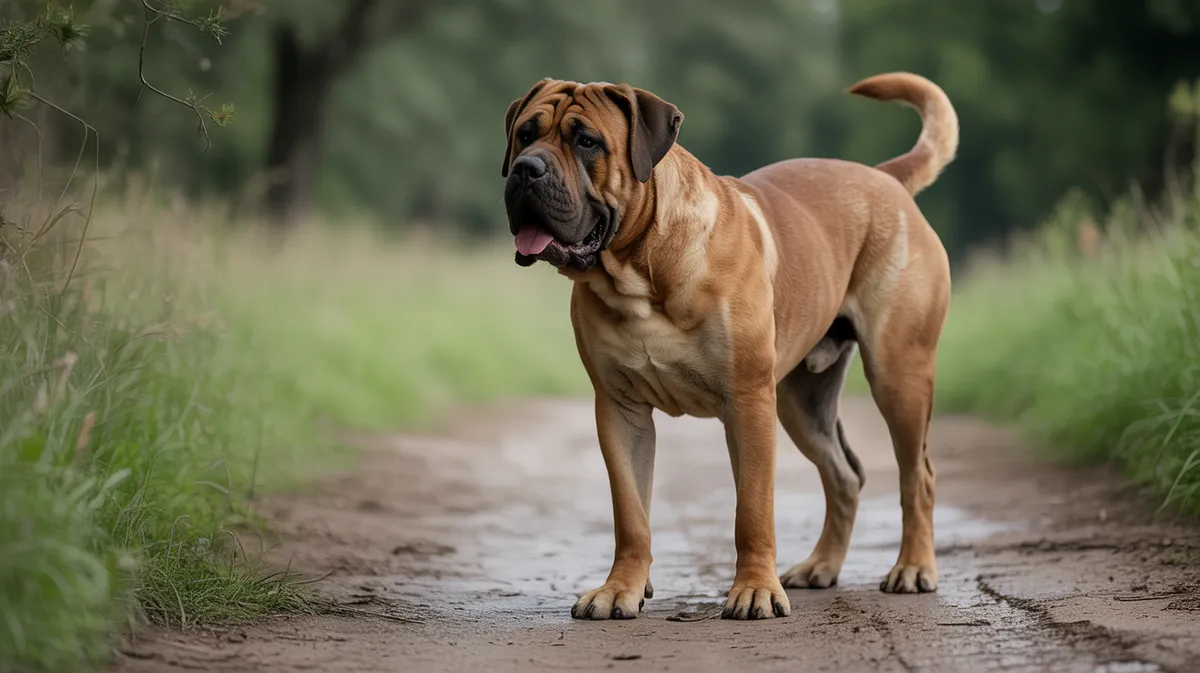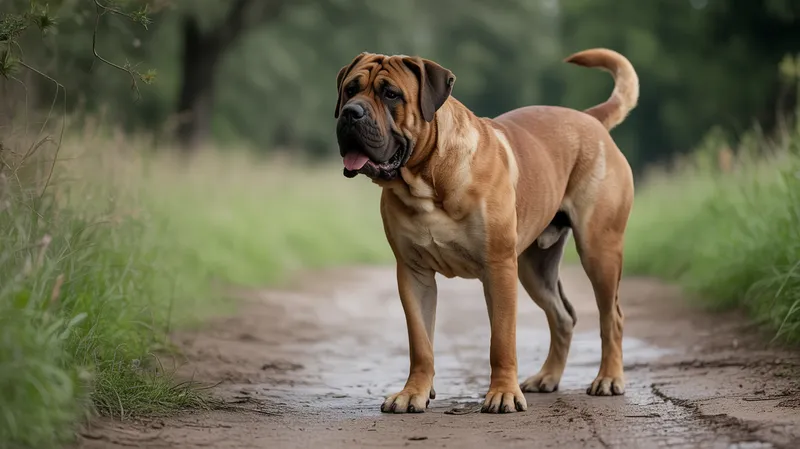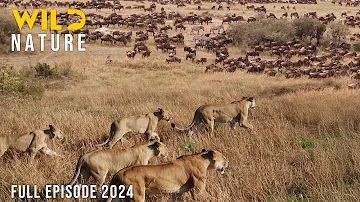
Boerboel
Canis lupus familiaris

Meet the Boerboel
The Boerboel is a large, powerful dog breed originally developed in South Africa as a farm and estate guardian. Renowned for its protective instincts, intelligence, and strong bonds with family, the Boerboel is both a loyal companion and an effective working dog. This breed is muscular and athletic, with a confident demeanor and a calm, steady nature when properly socialized. While devoted and affectionate with their household, Boerboels require consistent training and early socialization to thrive as family pets.
Classification
Mammal
Habitat
Domestic; rural and suburban environments
Diet
Omnivore
Lifespan
9-12 years
Conservation
Not Evaluated
Weight
50-90 kg (110-200 lbs)
📖Fascinating Facts
Guarding Heritage
The Boerboel was selectively bred by South African farmers to protect homesteads from intruders and dangerous wildlife like leopards and baboons.
Impressive Strength
Boerboels are among the most powerful dog breeds in the world, with remarkable strength and agility for their size.
Family Guardian
This breed is known for its strong attachment to its family and is often described as a natural protector, especially towards children.
📋Detailed Description
The Boerboel is a robust, large-boned mastiff-type dog, typically standing 61–69 cm (24–27 in) at the shoulder and weighing between 50–90 kg (110–200 lbs), with males being larger and more muscular than females. Its body is powerfully built, featuring a broad chest, strong neck, and well-developed musculature, which contribute to its formidable presence and working capabilities. The head is blocky and broad with a pronounced stop, strong jaws, and medium-sized, V-shaped ears that hang close to the cheeks. The short, dense coat is smooth and lies close to the body, coming in shades of red, brown, fawn, brindle, and, per the South African Boerboel Breeders' Society, black. Boerboels are renowned for their intelligence, alertness, and unwavering loyalty to their family, forming deep bonds and displaying a natural protectiveness. They are highly trainable but require consistent, firm leadership and early socialization to channel their guarding instincts appropriately. Socially, Boerboels are generally calm and confident, showing affection and gentleness with those they trust, but they can be wary or aloof with strangers. Their high pain threshold and resilience make them well-suited for the demanding conditions of rural South Africa, where they historically served as guardians against predators and intruders. As working dogs, they exhibit notable stamina and agility, capable of patrolling large properties and responding swiftly to perceived threats. The breed's longevity averages 9–12 years, with proper care and attention to health concerns such as hip dysplasia and cardiac issues.
💡 Did you know?
Despite their formidable appearance, well-socialized Boerboels are gentle and affectionate with children, often becoming highly protective of them.
🔬Research & Sources
Wikipedia Summary
The Boerboel is a South African breed of large dog of mastiff type, used as a family guard dog. It is large, with a short coat, strong bone structure and well-developed muscles.
Last Modified: 6/10/2025
🎭Behavior & Social Structure
Boerboels are territorial and display strong protective behaviors, often patrolling their home environment and remaining vigilant for unfamiliar people or animals. They are not typically aggressive without cause but will respond assertively if they perceive a threat to their family or territory. Social interactions within the household are characterized by loyalty, affection, and a desire for close companionship; they often seek physical closeness and are known to be gentle with children when properly socialized. Their feeding behavior is typical of large domestic dogs, requiring a balanced, high-quality diet to support their muscular build and energy needs. While not bred for hunting, Boerboels retain some prey drive and may chase smaller animals if not trained. Daily routines should include regular exercise, mental stimulation, and structured activities to prevent boredom and destructive behaviors. They are responsive to positive reinforcement training and thrive in environments where clear boundaries and routines are established.
👶Reproduction & Life Cycle
Boerboels reach sexual maturity between 12 and 18 months, though responsible breeding is generally recommended after two years of age to ensure full physical and behavioral maturity. The breed exhibits no pronounced seasonality in breeding, as is typical for domestic dogs, but most breeders plan litters to avoid extreme weather conditions. The average gestation period is approximately 63 days. Litter sizes range from 7 to 10 puppies, though larger litters are not uncommon. Females exhibit strong maternal instincts, providing attentive care, nursing, and protection for their offspring. Puppies require early socialization and exposure to various stimuli to develop stable temperaments. Responsible breeders conduct health screenings for hereditary conditions such as hip and elbow dysplasia and cardiac issues to reduce the risk of passing on genetic disorders.
🛡️Adaptations & Survival
The Boerboel's physical adaptations include a dense, short coat that protects against both heat and cold, and a robust, muscular frame that enables it to confront large predators or intruders. Its powerful jaws and strong bite force are evolutionary traits derived from mastiff ancestors, aiding in deterrence and defense. Behaviorally, the breed's heightened territoriality, acute senses, and strong protective instincts are specialized adaptations for guarding livestock and property. Their intelligence and trainability allow them to assess situations and respond appropriately, distinguishing between normal and threatening stimuli. The breed's high pain tolerance and resilience are further adaptations to the challenging environments of rural South Africa, where encounters with wildlife and harsh conditions are common.
📚Research Sources
🎨Cultural Significance
The Boerboel holds a prominent place in South African culture, symbolizing strength, protection, and resilience. Historically, these dogs were indispensable to settlers and farmers, guarding homesteads and livestock from predators such as leopards, hyenas, and baboons. The breed's name derives from the Afrikaans words 'boer' (farmer) and 'boel' (dog), reflecting its agricultural heritage. Boerboels are celebrated in South African folklore and are often regarded as national treasures, embodying the spirit of the country's rural communities. Today, they continue to serve as loyal companions, working dogs, and status symbols, with dedicated breed societies promoting their preservation and responsible breeding.
🔬Recent Research & Discoveries
Recent research on the Boerboel has focused on genetic diversity, health screening, and temperament assessment. Studies have identified a need for comprehensive genetic testing to reduce the incidence of inherited diseases, particularly musculoskeletal and cardiac conditions. Behavioral research highlights the importance of early socialization and structured training to ensure stable temperaments, given the breed's strong guarding instincts. Ongoing studies are examining the breed's adaptability to urban environments and the impact of modern lifestyles on health and behavior. The South African Boerboel Breeders' Society and international kennel clubs are collaborating to standardize breed characteristics and promote ethical breeding practices.
🎥Wildlife Videos

THE BOERBOEL LION DOG - MOST POWERFUL MASTIFF IN SOUTH AFRICA
Anneka meets the mastiff with the strongest bite force in South Africa and maybe the world. A powerful guard dog with a history of ...
Animal Watch

Wildlife Stories: Love is in the Wild | SPECIAL | Free Documentary Nature
Wildlife Stories: Love is in the Wild | Special | Free Documentary Nature Watch 'Wildlife Stories: Talking to Survive' here: ...
Free Documentary - Nature

WILD SAVANNAH | Survival Stories from the Heart of Africa | Animal documentary
Welcome to "WILD SAVANNAH | Survival Stories from the Heart of Africa," an immersive wildlife documentary that plunges you ...
WILD NATURE - Nature animal documentary

WILD SERENGETI | Battle for Survival in Predator Territory | Animal documentary
Step into the untamed world of the Serengeti, a sprawling savanna where every moment is a fight for survival. In this gripping ...
WILD NATURE - Nature animal documentary

The Unique Wildlife of Brazil’s Rainforest
Explore the incredible biodiversity and unique ecosystems of Brazil's Mata Atlântica and other regions. The show delves into the ...
Real Wild

WILD KRUGER | Survival in The Wild Heart of South Africa | Animal documentary
WILD KRUGER | Survival in The Wild Heart of South Africa Welcome to an exciting journey through Kruger National Park – one of ...
WILD NATURE - Nature animal documentary
🌍Habitat Information
The Boerboel typically inhabits Domestic; rural and suburban environments environments. Boerboels have adapted to their environments with specialized features and behaviors.
Primary Habitat:
Domestic; rural and suburban environments
More detailed habitat information will be available soon.
🛡️Conservation Status
The Boerboel is currently classified as Not Evaluated. Conservation efforts are crucial for preserving this species for future generations.
Common Threats:
- 🏠Habitat loss and fragmentation
- 🌡️Climate change impacts
- 🎯Hunting and poaching
- 🏭Human-wildlife conflict
⚠️Threats & Conservation Challenges
While the Boerboel is not considered at risk in terms of population, the breed faces several challenges. Irresponsible breeding practices can lead to inherited health problems, including hip and elbow dysplasia, heart disease, and temperament issues. The breed's size and strength require knowledgeable and committed owners; inadequate training or socialization can result in behavioral problems, sometimes leading to breed-specific legislation or restrictions in certain countries. Overbreeding to meet demand has, in some cases, compromised genetic diversity. Additionally, urbanization and changing lifestyles may reduce the need for traditional working roles, potentially impacting the breed's future utility and popularity.
🔬Scientific Classification
Scientific Name
Canis lupus familiaris
Classification Hierarchy
🔍 About Taxonomic Classification
Taxonomic classification is a hierarchical system used by scientists to classify and organize living organisms based on shared characteristics and evolutionary relationships.
The system moves from broad categories (Kingdom) to increasingly specific ones, with each animal's scientific name typically consisting of its Genus and species.
📝Community Notes
Share your observations and insights about the Boerboel with our community of wildlife enthusiasts.
Join Our Community
Sign in to share your observations and connect with fellow wildlife enthusiasts.
Sign In to ContributeNo community notes yet
Be the first to share your observations about the Boerboel!
Explore Boerboel
Select a tab above to learn more about this amazing animal.
📸Photo Gallery
No photos available for this animal yet.
🌟Discover More Wildlife
Continue your journey of discovery with more fascinating animals from our database
